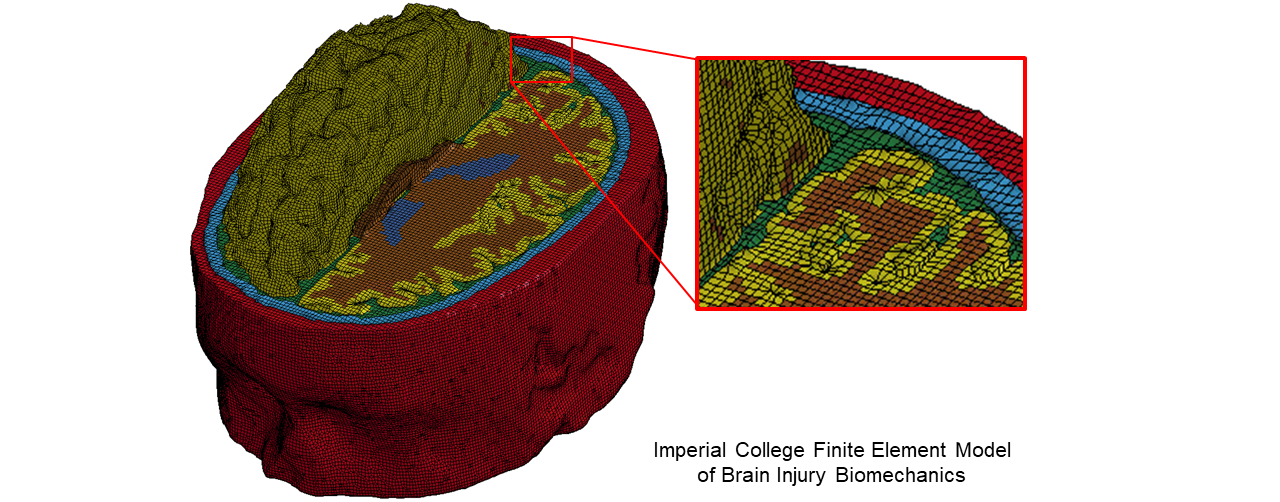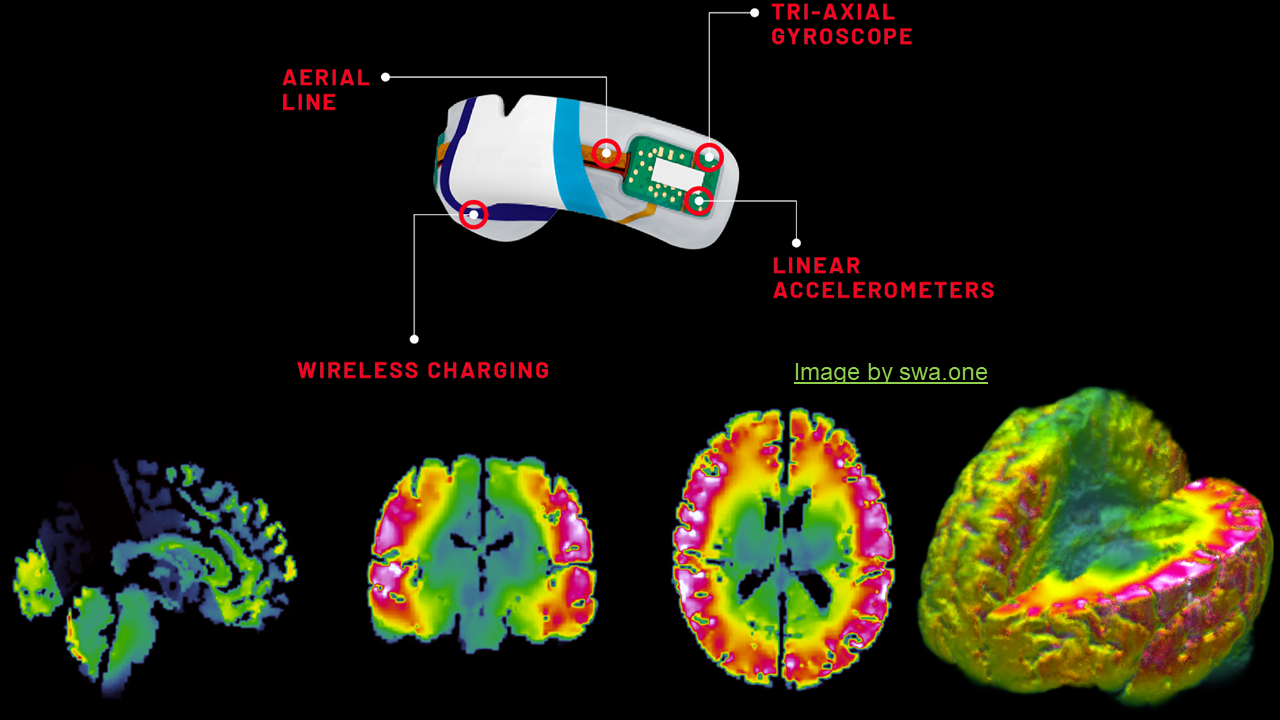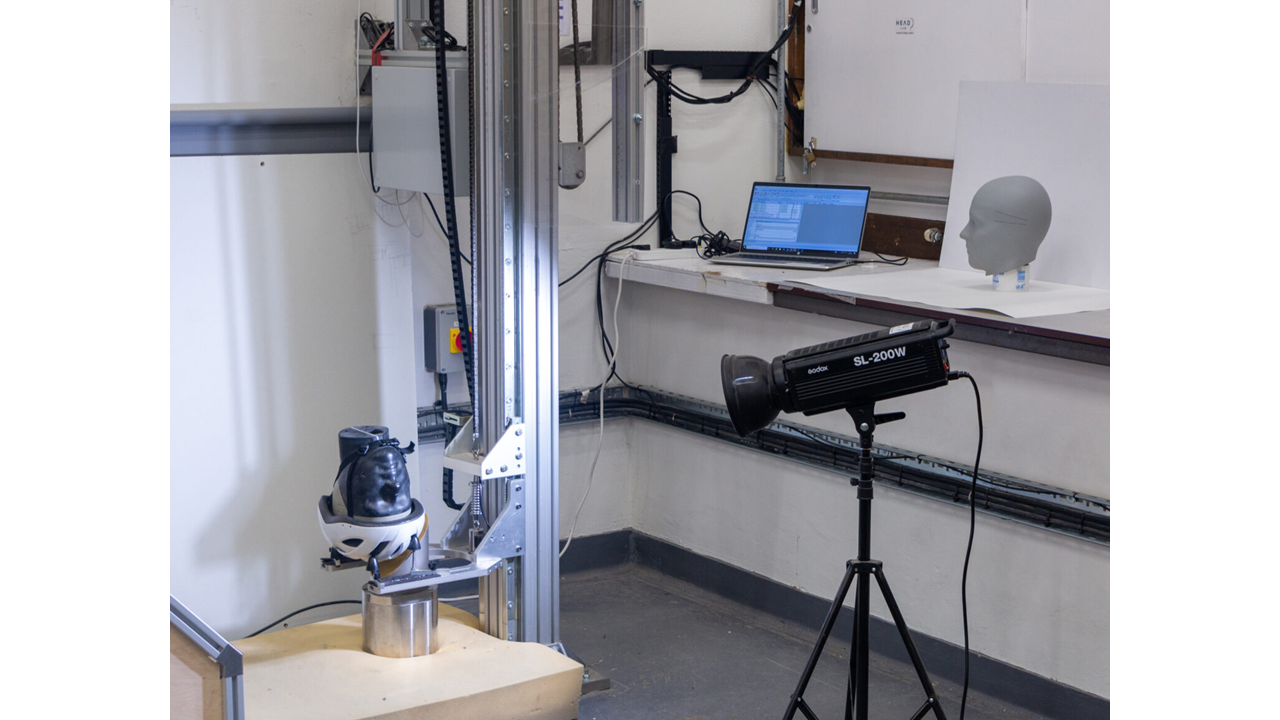Our brain is the most complex system known to us. Road traffic incidents, sporting activities, falls, disease or surgical interventions can subject our brain to large mechanical loads, which can damage our brain.
At HEAD lab, we focus on understanding the effects of mechanical loading on the brain and using this fundamental understanding to develop applied solutions to predict and prevent brain injuries.
Our Projects
We develop high fidelity computational models of brain biomechanics and use them to predict the effects of mechanical loading on brain tissue.
We have developed the Imperial College Finite Element Model of Brain Injury Biomechanics, which incorporates fine details of brain anatomy, such as sulci.
This model has allowed us to predict the location of the pathology in the dementia disease, chronic traumatic encephalopathy (CTE). Press release: https://www.imperial.ac.uk/news/179073/3d-model-american-football-players-brain/
In addition, this model has also allowed us to reveal the biomechanical signature of loss of consciousness. Press release: https://www.imperial.ac.uk/news/243996/sports-related-brain-injuries-reveal-mechanics/
Biomechanics of Axonal Injury
Exposure of the white matter to loading can damage its key structural elements, the axons. Axons are the long projections of nerve cells. Axonal damage can determine long-term outcomes after traumatic brain injuries. Our aim is to better understand how deformation of the white matter in trauma and disease can damage axons. We use this understanding to improve our prediction tools and design prevention strategies.
This work is funded by a Dyson School of Design Engineering PhD Scholarship. We collaborate with neuroscientists at Imperial College Brain Sciences Department to access human data and understand injury patterns.
Individualised Brain Models
Biomechanical brain models are built based on a geometrical description of the brain anatomy, obtained from brain images such as MRI. We have developed a semi-automatic pipeline that allows us to build a brain model from an MRI scan, incorporating fine details of the brain anatomy. Our aim is to use this approach to improve our understanding of the effects of anatomy on the mechanical response of the brain in trauma and disease. We will incorporate these findings in brain surveillance systems.
This work is part of the Sports and Wellbeing/Cellbond Impact Solutions/Royal Academy of Engineering Senior Research Fellowship.
From Biomechanics to Pathology
This work is another example of the strong and unique collaboration between Design Engineering and Brain Sciences at Imperial College. We used high fidelity biomechanics modelling of traumatic brain injury in rats, empirical modelling of controlled cortical impacts in rats, high intensity MRI, and quantitative histopathology to understand the relationship between white matter deformation and damage. We showed that large brain deformations produced at the time of injury can predict structural changes in white matter two weeks post-injury. This understanding confirmed the validity of using brain tissue deformation to predict short and long-term effects of mechanical loading on brain tissue. Press release: https://www.imperial.ac.uk/news/212873/precise-mapping-shows-brain-injuries-inflict/
This work was funded by Wellcome Trust Networks of Excellence and Centre for Blast Injury Studies.
Biomechanics of Vascular Injury
Cerebral vasculature injury is a form of traumatic brain injury (TBI), where the blood vessels in the brain are damaged, causing intracranial bleeding. We have led studies to understand the relationship between mechanical loading of vessels and their damage in humans and rats.
We have incorporated details of the venous system within our brain model. With this model, we studied the patterns of large strains in small vessels during head loading and the location of microbleeds after head loading. We found an overlap between large stretches of vessels and microbleeds in a rugby impact. Our aim is to extend this study to a range of cases and establish a threshold for vascular damage.
An overview of our paper on prediction of blood brain barrier damage by biomechanical finite element modelling of vascular injury
We have also incorporated a map of cerebral vasculature, with a 5 microns resolution obtained from synchrotron imaging, in our finite element model of rat brain biomechanics. Using this model and quantitative histopathology of rat brain tissue subjected to impacts, we found that there is an interaction between the anatomy of capillaries and loading distribution in producing blood-brain barrier damage. Press release: https://www.imperial.ac.uk/news/226433/brain-injury-computer-models-brain-blood
An overview of our paper on prediction of blood brain barrier damage by biomechanical finite element modelling of vascular injury
This work was funded by Wellcome Trust Seed Awards in Science and EPSRC DTP studentship.
Looking for a collaboration?
Contact us
For queries, please contact Mazdak Ghajari:
- Email: m.ghajari@imperial.ac.uk
- Phone: +44 (0)20 7594 9236
Opportunities
If you are interested in the work we do and are interested in postgraduate (PhD) or postdoctoral research, you can find more information about scholarships and fellowships below:
- General Scholarship Information
- China Scholarship Council
- President's PhD Scholarships
- Imperial College Research Fellowships
We are also interested in Undergraduate Research Opportunities Programme applicants.
Please get in touch with Mazdak Ghajari in the first instance if interested in applying.










